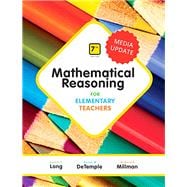For courses in Mathematics for Teachers or Mathematics for Future Elementary Teachers.
Fosters reasoning skills, deep conceptual understanding, and a positive attitude to aspiring elementary or middle school teachers
Mathematical Reasoning for Elementary Teachers presents the mathematical content needed for teaching within the context of the elementary classroom. The authors endeavor to answer the frequently asked question “Why are we learning this?” by going beyond skill explanations to show how these concepts are implemented in the future classroom, and what types of questions children may ask. The Common Core State Standards for Mathematics are included.
This Media Update for the 7th Edition features:
- Education Insights video program adapted from teacher education videos, produced with assessment questions, worksheets, and an implementation guide
- Common Core in Action videos with assessment questions
- Common Core Assessment Analysis questions
- GeoGebra animations with assessment questions
- Assessment questions for lecture videos
- MindSet material.
Personalize learning with MyLab Math
By combining trusted author content with digital tools and a flexible platform, MyLab Math personalizes the learning experience and improves results for each student.
Note: You are purchasing a standalone product; MyLab Math does not come packaged with this content. Students, if interested in purchasing this title with MyLab Math, ask your instructor to confirm the correct package ISBN and Course ID. Instructors, contact your Pearson representative for more information.
If you would like to purchase both the physical text and MyLab Math, search for:
0135167469 / 97801351674 Mathematical Reasoning for Elementary Teachers Plus MyLab Math Media Update - Access Card Package, 7/e
Package consists of:
- 013475882X / 9780134758824 Mathematical Reasoning for Elementary Teachers - Media Update
- 013476675X / 9780134766751 MyLab Math with Pearson eText - Access Card - for Mathematical Reasoning for Elementary Teachers - Media Update









